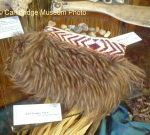Collections
Our Cambridge Collection has changing exhibitions about Cambridge. Much of our collection is in storage to ensure its preservation for future generations.
Archaeology

Throughout the Cambridge district there are approximately 80 archaeological sites. There are pa, borrow pits, redoubts, flour mills, a mission station and a battle site.
The New Zealand Archaeological Association Inc have listed these sites with Waipa District Council. The Council’s policy follows the Historic Places Act 1993 whereby sites associated with human activity that occured before 1900 are protected whether or not they are registered by Heritage New Zealand, and authority to destroy or modify any archaeological evidence is required from the Trust.
Waipa District Council’s general rule is – “No alteration shall be made to landform, trees, bush or any other physical feature on any heritage site included in Appendices 11 and 12 or any urupa or waahi tapu and other taonga sites identified in any consultative process except with the consent of the Council and/or the appropriate Heritage Authority where it is necessary to do so for the preservation of the heritage values of the site or for matters of public safety.”
Circa 1600, Te Ihingarangi built a pa (a fortification near Lake Karapiro where the water reservoirs are today) called Te Tiki o Ihingarangi. He later moved to Maungatautari and his son’s tribe became known as Ngati Raukawa. Te Rauparaha persuaded the Ngati Raukawa to go south with him. Koroki lived on the south side of the Waikato River near Cambridge, at a pa called Horotiu. From his sons descended the Ngati Haua and Ngati Koroki. The Cambridge area was known as Karapiro.
In 1821 Hongi Hika of the Ngapuhi (Bay of Islands) came south and destroyed the Te Totara pa of the Ngati Maru at Thames. The Ngati Maru who escaped from Thames came to Maungatautari and built Haowhenua – a pa on Luck at Last Road.
In 1830 Te Waharoa of Ngati Haua fought the Ngati Maru in the Battle of Taumatawiwi (2km south of the Karapiro Domain) and sent Ngati Maru back to Thames. Ngati Koroki then returned to Maungatautari.
The Maori King movement started in 1857 with Potatau and soon after, in 1860, Tawhaio. Wiremu Tamihana (son of Te Waharoa) was a leading chief keen on the formation of the King Movement.
The British invasion of the Waikato began in 1863 and Te Tiki o Ihingarangi was the last stand for Tamehana. A couple of shots were fired but on the night of 5 April 1864 Tamehana took his people across the river and settled at Peria near Matamata.
The British took over the pa making a redoubt called the Crow’s Nest on the same hills. The Confiscation (Aukati) Line was made across the Pukekura hills towards Te Awamutu.
In July of 1864 the Star Redoubt was built in Cambridge on the ground where the Museum now stands. The settlement was going to be at the Crow’s Nest but the paddle steamers could not get that far up the river and turn around safely.
Cambridge was named after the Duke of Cambridge who was Commander in Chief of the British Army and cousin to Queen Victoria.
Links
Maungatautari Ecological Island Trust
New Zealand Archaeological Association
Heritage New Zealand
